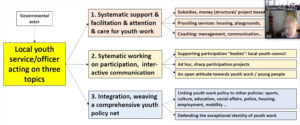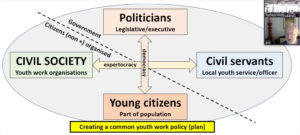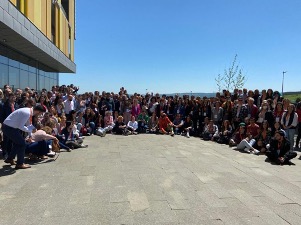Articles
Europe goes local and reloads democracy
Written by Laszlo Foldi
The 4th Europe goes Local Conference took place on 17-19 May in Cluj, Romania. More than hundred young people, youth workers, municipality officers, researchers and other stakeholders met to look into important aspects of local youth work and youth participation.
If we consider youth work and youth policy also as a tool to improve youth participation in broader terms as well as in democratic decision-making then we cannot ignore one of the most challenging aspects of youth policy, the contradictory but beautiful connection between young people and the municipal authority, usually but not always supported by youth work. One of the 24 competences of the Democracy Reloading Reference Framework suggests for municipality officers “I communicate and cooperate with young people on equal grounds and with appropriate language”. What do you think? Is it a realistic competence for you? Can we really expect to establish meaningful communication and cooperation between young people and decision-makers? We should think of important officers, or as some latin languages call it, a “fonctionnaire”, or as the modern approach dreams: a civil servant, and we should also think of busy politicians, an elected citizen to represent hundreds of thousands or millions of others.
As we know young people are not a homogeneous mass, on the contrary in terms of culture and social backgrounds it is the most colourful and diverse cohort sharing mainly one common character: age. And civil servants – if you allow me to use my favourite title – are neither easy cooperation partners as they make up a sometimes transparent but very complex system and in some cases a structure that more resembles a secret society than a public service. Furthermore, such a relationship of dialogue (between decision-makers and young people) cannot really be established without professional youth workers, as one of the 36 recommendations of the European Charter on Local Youth Work puts it “to stimulate and support young people to be active citizens and exercise influence in society, including taking part in political decision-making”.
Here we are in the conjunction of a great variety of needs, interests and realities. Challenging enough? Good! And as we walk through the Reality is coming forth: a youth policy officer who – in most of the cases – was never trained for this job, a politician who – in most cases – never heard of youth policy, a youth worker who – in most of the cases – has mainly their enthusiasm and goodwill, and some young people who happen to be privileged enough to be around. I know that there are much luckier and more ideal situations and realities, however to understand the real challenge and be prepared for every scenario, we better face a less kind world. So here they are looking at each other (in the luckier scenario they see each other), but look who is coming there, Europe is approaching, it seems that she is coming local, with a bunch of dossiés (one called EGL Charter, the other Democracy Reloading, and many more) under their arms smiling, full of hope and enthusiasm. She distributes all the dossies she brought and also gives some money and leaves quickly as she is very busy, she must go to a lot of locals.
There they stay on their own, the locals. Looking at each other, or the ones they see. What is next? Hopefully one of them says “Let’s do something!” or “Let’s try this!” or “Let’s see how others are doing!”.
European youth policy has existed for about 50 years, and in some European countries there is still no national long term youth policy approach. There are thousands of settlements in Europe where the municipality cannot or does not want to deal with youth in a strategic manner. We – the youth work natives – know how important youth work, youth strategy, youth policy and youth participation are for building a resilient society. We know what it can do, and we know what can happen without. We know how outdated the educational system is, and we know how youth work can complement what is missing. We also know that we are at the beginning of the road, if there is a road at all (I prefer believing that there is!).
In some cases, in some locals there is nothing else than these dossies from Europe, and in some cases the locals far overcame what the dossies can provide. However these are the references along which we can discuss challenges and achievements, learn from each other and develop the services further. These dossies collected the essences and the principles that can help overcome barriers, reflect on failures, identify weaknesses and look at local reality with several perspectives. They are not recipes, nor checklists, they cannot work instead of us, they cannot solve problems without us. These dossies are not more than supporting pillars or walking sticks, but not less either.
What can we do with young people to participate in municipal decisions? How can we improve local democracy?

Let me quote from professor Guy Redig (Belgium), who also gave a lecture during the 4th Europe Goes Local Event (slides are from his presentation), describing youth policy as “trying to manage a wanted future”. There comes the very good question from our little local team: What is the future we want to manage towards? First challenge. The local stakeholders usually do not agree in this future. How to make them agree, how to find the common denominators. The Democracy Reloading Toolkit TASK 1 (with 6 specific competences) includes several hints and practices to reach such a common platform of a desired future.
The first, maybe the most important task is “Creating a supportive environment within the municipality to involve young people in decision-making (TASK 1)”. It means that the organisational culture of the municipal authority is ready, motivated and competent to share decisions with local youth. It means that all those who can influence the process of involving youth are for it, are proactive and skilled. Otherwise do not even start. The Toolkit also includes arguments, means and practices on how to create an optimal supportive environment within the organisation of the municipality. If you visit the Democracy Reloading website you can also take a self-assessment test that will provide you with a stakeholder analytics as a starting point, and kick off your empowerment process. The greatest challenge inside a municipality is usually the attitude of the hierarchy and the decision-makers. Are they really ready to share their power? Are they really open to listening to young people? Are they convinced that youth can be involved in a meaningful sharing of certain powers? Of course the answers are usually hidden in the details of the how. While preparing young people for being empowered, you have to pay attention to ensuring that the holders of power are also empowered to really share certain bits of their power, otherwise you may end up with a superficial performance of meaningless impact. Ideally you strat with fulfilling TASK 1, then TASK 2, then TASK 3 and lastly TASK 4.
Let’s say that the municipality is ready and competent in all aspects to involve young youth to have their voice in municipal decisions. The next big challenge is to create a representative structure and system for young people to influence local policies. This work can only be successful with professional youth workers who know how to reach out to a great diversity of youth, how to empower them, how to engage them and keep them engaged, how to create a safe space for them to express their voice the way they feel comfortable. In this effort of providing high quality youth work the European Charter on Local Youth Work can be a light tower, it provides clear recommendations on how youth work should be organised and implemented. So to say it paves the way with the main principles of efficient and effective youth work. Organising and ensuring quality youth work is also the responsibility of the municipal government, civil society can help a lot but they also need guidance and resources in this regard. You can also find hints and guidance in the TASK 2 of the Democracy Reloading Toolkit on “Empowering young people and their organisations and communities to participate in municipal decision-making”. Especially on the role and responsibilities of the municipal organisation in relation to finding the relevant young people, understanding the real needs and ideas of youth people, and building up and maintaining partnership with youth.

TASK 3 “Developing policy, strategy and structure for youth participation in decision-making” is about the art of planning efficient strategies. Youth policy shall integrate several aspects of life of local youth and it is ideally integrated in a holistic social development strategy for referring to all groups of local society. You should work with well established and measurable indicators connected to the strategic objectives. For youth participation you should have a specific section that includes very clear objectives in relation to youth participation in municipal decision-making. In this regard the Democracy Reloading Toolkit TASK 3 will provide some further hints and references on how to develop an integrated participation strategy. You have to make sure that you engage experienced professional youth workers who can also support the involvement of young people in municipal decisions. You have to know what decisions the municipality isd ready to share with youth and how. All actors must know what they can expect from each other and what mandate and impact youth can have. You must keep in mind that young people are there now, not only in the future, so try to avoid working along the cliché of “young people are our future”. There are many practices of youth participation structures starting from the good-old local youth councils to the online consultation mobile apps. You must remember that there is no receipt, one concept may work here but it is not certainly effective there. You cannot avoid experimenting based on practices that you know. It is essential that you know a number of solutions from other settlements of your region, your country or Europe. The more you know, the more ingredients you have for “cooking” your version. Testing, assessing and evaluation are your best friends along the way and be brave to mix approaches and create new solutions. Do not believe anyone who wants to tell you what and how to do. And last but not least document everything and frame the system and structure by local legislation so that it does not depend on the mood of people.
 Now that the municipality is up for it, young people are empowered and prepared for it, you have a strategy and a structure planned and ready. Let’s see the challenges of the implementation. TASK 4 “Managing youth participation in decision-making and validating its impact” will give you some important hints and resources on how to actually make it work. Being and communicating with young people requires competences form all relevant staff of the municipal organisation, they should be all in, all constructive and cooperative. They should feel comfortable in this role and they should like this approach otherwise things will not work out as wanted. There are many stakeholders of such a system so the whole community of stakeholders should be managed well, taken care of. Relevant budgets and resources should be available in due time, and projects should be integrated well. EU funds can be and should be involved, and do not be afraid of going digital, use appropriate web and mobile apps as much as you can, as this generation is digital natives, be open to learning from them too. Last but not least, always think about disseminating results and challenges with the wider citizens’ group.
Now that the municipality is up for it, young people are empowered and prepared for it, you have a strategy and a structure planned and ready. Let’s see the challenges of the implementation. TASK 4 “Managing youth participation in decision-making and validating its impact” will give you some important hints and resources on how to actually make it work. Being and communicating with young people requires competences form all relevant staff of the municipal organisation, they should be all in, all constructive and cooperative. They should feel comfortable in this role and they should like this approach otherwise things will not work out as wanted. There are many stakeholders of such a system so the whole community of stakeholders should be managed well, taken care of. Relevant budgets and resources should be available in due time, and projects should be integrated well. EU funds can be and should be involved, and do not be afraid of going digital, use appropriate web and mobile apps as much as you can, as this generation is digital natives, be open to learning from them too. Last but not least, always think about disseminating results and challenges with the wider citizens’ group.
Be yourself! Be original! Be democratic!
